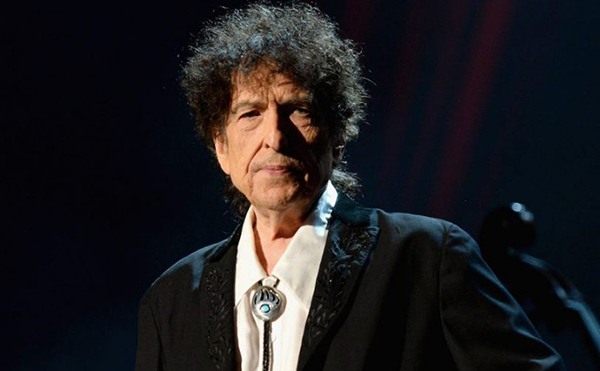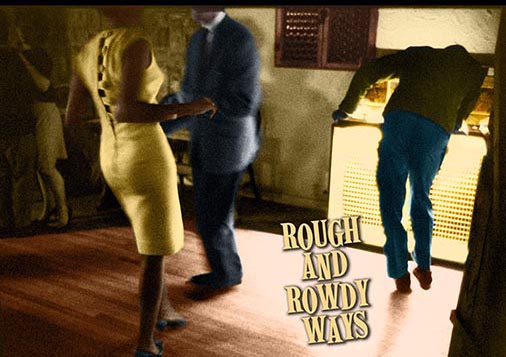
After eight years Bob Dylan returns with his first double album of original songs since Blonde On Blonde and it’s an absolute masterpiece.
By Michael Goldberg.
Bob Dylan is 79 years old and he knows it. His new album, Rough and Rowdy Ways, his first double album of original material since 1966’s Blonde On Blonde, is at once a look back at the world as Dylan has known it, but also an album that deals with the profane and the spiritual, and implies you can’t have one without the other.
Repeatedly in the 10 new songs, Dylan writes about the commission of sin and a striving for absolution. But don’t think everything in the songs here has religious overtones. He sings of love, of lust, and of murder – most foul. And there’s humor too, even when he sings about death.

In ‘False Prophet’ Dylan boasts like a young rapper, but you can hear the smile on his face:
“I’m first among equals
“Second to none
“Last of the best
“You can bury the rest
“Bury ’em naked with their silver and gold “Put them six feet under and pray for their souls”
Or this from ‘I Contain Multitudes’:
“I’ll sell you down the river, I’ll put a price on your head
“What more can I tell you? I sleep with life and death in the same bed”
He says he doesn’t think about his own mortality; his concerns go beyond that. “I think about the death of the human race,” Dylan said in a rare interview that ran in the New York Times on June 12, 2020, conducted by Douglas Brinkley, a professor of history at Rice University who authored American Moonshot: John F. Kennedy and the Great Space Race. “The long strange trip of the naked ape. Not to be light on it, but everybody’s life is so transient. Every human being, no matter how strong or mighty, is frail when it comes to death. I think about it in general terms, not in a personal way.”
In the New York Times, Brinkley summed up the album. “‘Rough and Rowdy Ways’ covers complex territory: trances and hymns, defiant blues, love longings, comic juxtapositions, prankster wordplay, patriotic ardor, maverick steadfastness, lyrical Cubism, twilight-age reflections and spiritual contentment.”
Rough and Rowdy Ways, an absolute masterpiece, is also an album about Bob Dylan and he admits as much. Speaking about the opening track, ‘I Contain Multitudes,’ Dylan said, “It is my identity.” And of the 17-minute-long reflection on the death of John F. Kennedy, ‘Murder Most Foul,’ he said, “To me it’s not nostalgic. I don’t think of ‘Murder Most Foul’ as a glorification of the past or some kind of send-off to a lost age. It speaks to me in the moment.”
Throughout the album Dylan shares his love for music, and particular musicians. He names a song after Jimmy Reed, but between ‘I Contain Multitudes,’ ‘Murder Most Foul’ and ‘Key West (Philosopher Pilot),’ dozens of other musicians are also named or referred to by way of their songs: Elvis, the Rolling Stones, Billy Joe Royal, Warren Smith, Louis Armstrong, Carl Perkins, Otis Redding, Thelonious Monk, Guitar Slim, Nina Simone, the Eagles, Etta James, the Beach Boys, John Lee Hooker, Patsy Cline, the Who, and on and on.
With the world in the midst of a ruthless pandemic, and Americans of all races and religions out in the streets protesting the systemic injustice that Blacks have faced for hundreds of years that is a different kind of ruthless black plague, Dylan’s timing in returning with a new album, this album, is perfect.
Dylan was singing about racial injustice in the early ’60s; he was also singing about the brute force the authorities used, a brute force no different than what the police used on George Floyd. He wrote about the vicious murder of 51-year-old Hattie Carol and defended in song Rubin ‘Hurricane’ Carter and the murdered Black Panther George Jackson.
In his New York Times interview, Dylan was asked about the murder of George Floyd, which took place in Minnesota, the state where Dylan was born and grew up. “It sickened me no end to see George tortured to death like that,” Dylan said, sounding depressed according to the interviewer. “It was beyond ugly. Let’s hope that justice comes swift for the Floyd family and the nation.”
In 1964 Dylan, with few exceptions, stopped writing topical folk songs. Since then he’s been writing for the ages (although ‘Masters of War,’ and many of his topical folk songs turned out to be for the ages too), which often makes his songs timely at any time. I would wager some of these Rough and Rowdy Ways songs will be listened to by future generations.
Nearly as soon as Dylan established himself with ‘Blowin’ in the Wind’ (when it became a hit for Peter, Paul and Mary in August 1963), he began confounding expectations. In case anyone still wants to box Dylan in, he reminds us at the very start of Rough and Rowdy Ways, ‘I Contain Multitudes,’ that he “is a man of contradictions, a man of many moods.” The title and the theme come from section 51 of Walt Whitman’s ‘Song of Myself,’ in which Whitman wrote, “Do I contradict myself?/ Very well then I contradict myself, / (I am large, I contain multitudes.)”
Dylan has been inspired by Whitman since the ’50s (“On 7th Avenue I passed the building where Walt Whitman lived and worked,” Dylan wrote in his memoir, Chronicles Volume One, talking about when he first got to New York in 1961. “I paused momentarily imagining him printing away and singing the true song of his soul.”); ‘Cross the Green Mountain,’ which on the soundtrack for the 2003 film, ‘Gods and Generals,’ and concluded the 2008 Bootleg Series set, Tell Tale Signs, references lines from Whitman’s ‘Come Up from the Fields, Father.’
Dylan said in the interview that ‘I Contain Multitude’’ “is trance writing…It’s the kind of thing where you pile up stream-of-consciousness verses and then leave it alone and come pull things out. In that particular song, the last few verses came first. So that’s where the song was going all along. Obviously the catalyst for the song is the title line. It’s one of those where you write it on instinct. Kind of in a trance state. Most of my recent songs are like that. The lyrics are the real thing, tangible, they’re not metaphors. The songs seem to know themselves and they know that I can sing them, vocally and rhythmically. They kind of write themselves and count on me to sing them.”
That Dylan says his new songs are not metaphors is a revelation. Consider that in 2004, speaking to Robert Hilburn of the L.A. Times about ‘Just Like a Woman,’ Dylan said, “I don’t think in literal terms as a writer. That’s a fault of a lot of the old Broadway writers…. They are so literal. There’s no circular thing, nothing to be learned from the song, nothing to inspire you. I always try to turn a song on its head. Otherwise, I figure I’m wasting the listener’s time.”
Perhaps recording three albums of Tin Pan Alley songs, most of which Frank Sinatra had first recorded, helped to change Dylan’s approach to songwriting. It’s obvious recording those songs had an impact on Dylan’s singing on the new album. Gruff and raw when handling the blues, but nearly angelic on the love song, ‘I’ve Made Up My Mind to Give Myself to You’ and the (at times) inspirational ballad, ‘Key West (Philosopher Pilot).’
In a rare admission, Dylan said that ‘I Contain Multitudes’ is about him. “It’s the way I actually feel about things. It is my identity and I’m not going to question it, I am in no position to. Every line has a particular purpose. …”
Still, to only take the songs on this album literally would be a mistake. While they may be about the writer, there is much more to these songs. Dylan considers the past (“We have a tendency to live in the past…,” Dylan says) even as he takes steps towards the future. There are references in ‘I Contain Multitudes” to Warren Smith’s 1957 recording for Sun Records of ‘Red Cadillac and a Black Moustache’ (which Dylan covered for the 2001 Sun Records tribute, Good Rockin’ Tonight: The Legacy of Sun Records), to Gene Vincent and the Blue Caps’ 1957 recording, ‘Red Blue Jeans and a Ponytail’ and to Carl Perkins 1958 recording for Sun Records, ‘Pink Pedal Pushers.’
Dylan alludes to countless songs and namedrops generals and Greek Gods, poets, playwrights and novelists, William Shakespeare and William Blake and Edgar Allen Poe, Allen Ginsberg, Gregory Corso and Jack Kerouac, Ludwig Van Beethoven and Frédéric Chopin. There’s a strange tribute of sorts to Jimmy Reed, and mentions of Elvis. Cover art for the third single, ‘False Prophet,’ features artwork borrowed from the cover of a 1942 issue of ‘The Shadow,” about the infamous crime fighter who could “cloud men’s minds so they cannot see him” and who knew “what evil lurks in the hearts of men.”
But, really, do all these references matter? Or are they simply personal touchstones, a different kind of memoir? Or maybe that’s the point. As a living legend, the music and musicians, culture and history, philosophy and spirituality that has excited and inspired Bob Dylan, allowed him to grow into who he is today, matters. This is BOB DYLAN after all, and if you care about Bob Dylan and he cares about ‘Red Cadillac and a Black Moustache,’ well the least you can do is give that song a listen.
But what if you knew none of Dylan’s references? What if you took his lyrics at face value? When I first heard Dylan, that’s exactly what I did. As a 13 year old hearing ‘Like a Rolling Stone’ and ‘Positively Fourth Street’ on the radio in 1965, and in the months that followed, listening again and again to Highway 61 Revisited, and his earlier albums, which I bought up as soon as I had the money, for the most part I didn’t know Dylan’s references. I certainly didn’t know when he was lifting words from Kerouac and using them in ‘Tombstone Blues’ or borrowing the melody of ‘Nottamun Town’ for ‘Masters of War.’
None of that mattered. What got me was the way Dylan’s voice and words and music came together into a force that reached deep into my soul, helped me find my own identity, and pointed me in a direction that I have pursued ever since. Of course Dylan’s words matter, but it’s not his words alone that have made him one of our greatest artists. And on Rough and Rowdy Ways, it is the totality of voice, music, words that make these songs so memorable – makes them songs I want to hear over and over.
Trying to figure out Dylan’s many references can be fun, even when some (many?) of those references seem, in a way, to be red herrings. Others truly add resonance. I’ll leave it to you to sort them out. And here’s another way to look at those lines and concepts. Dylan collects melodies, lyrics, and phrases. He finds them everywhere, keeps them in a box and sometimes when he’s writing he dips into the box for inspiration. At least he’s done that in the past. So it’s not always that the reference is symbolic. Sometimes it’s how the song (or the verse) came to exist.
In an interview published in England’s Uncut magazine in 2008, Dylan’s current engineer Chris Shaw talked about Dylan’s approach to recording. “His songs kind of continuously evolve,” Shaw said. “They’re not static. For him, it’s all about getting the track to fit the words, and not the other way around. So that’s why there are so many bootlegs, six different versions of ‘Like A Rolling Stone,’ four different versions of ‘Visions Of Johanna,’ he’s always trying to find the arrangement that works best with the sentiment he’s trying to express. To that end, he might say, ‘Well, I’m kinda hearing this like this old Billie Holiday song.’ And so we’ll start with that, the band will actually start playing that song, try to get that sound, and then he’ll go, ‘Okay, and this is how my song goes.’ It’s a weird process, and it’s unique to him out of any of the bands I’ve worked with over the past 20 years. It’s always interesting, always unbelievably exciting, and it’s a lot of hard work – and I mean that in a very good way. His sessions are always challenging, but, at the end of the day, you always feel like you’ve got something done, and you’ve done the best to get the song to work.”
The title of Dylan’s new album, Rough and Rowdy Ways, comes from a song, ‘My Rough and Rowdy Ways’, that Jimmie Rodgers and Elise McWilliams wrote and Rodgers recorded in October 1929. Here are some of the lyrics:
“For years and years I’ve rambled drank my wines and gambled
“But one day I thought I’d settle down
“I met a perfect lady she said she’d be my baby
“We built a cottage in the old hometown
“But somehow I can’t forget my good old rambling days
“The railroad trains are calling me away
“I may be rough I may be wild I may be tough and countrified
“But I can’t give up my good old rough and rowdy ways”
It’s a great album title, and it sure seems to characterize Dylan. There are three rough and rowdy 12-bar blues here. ‘False Prophet’ you’ve already heard, but give a listen to ‘Goodbye Jimmy Reed’ and the incredible ‘Crossing the Rubicon.’ Dylan has been singing the blues since at least the late ‘50s, and starting with his first album, Bob Dylan, his blues have wrung true and they are still the real thing.
Chris Shaw, who first worked with Dylan on the song ‘Things Have Changed’ in 1999, recorded and mixed the new album, and, according to Dylan’s management, “the majority of the music is played by Bob’s touring band.” Dylan’s most recent touring band consists of Donnie Herron, pedal steel, lap steel, electric mandolin, accordion, banjo, violin; Charlie Sexton, lead guitar; Tony Garnier, bass; Matt Chamberlain, drums, percussion; and Bob Britt, guitar.
There is a repetitious, hypnotic quality to many of these songs. The music circles, often seeming on the verge of resolving, but then circles again, almost resolves, circles once more. It’s very beautiful, sometimes ominous, and sometimes angelic. I can hear a harp at times, though there is no harp. I don’t think I’ve every heard anything like the music to ‘My Own Version of You,” ‘Black Rider,’ ‘Key West (Philosopher Pilot)’ and ‘Murder Most Foul.’ The structure of these songs allows for many verses and, when he wants, no chorus.
When Brinkley said to Dylan that it’s as if Charlie Sexton and Dylan can read each other’s minds, Dylan said, “As far as Charlie goes, he can read anybody’s mind. Charlie, though, creates songs and sings them as well, and he can play guitar to beat the band. There aren’t any of my songs that Charlie doesn’t feel part of and he’s always played great with me. ‘False Prophet’ is only one of three 12-bar structural things on this record. Charlie is good on all the songs. He’s not a show-off guitar player, although he can do that if he wants. He’s very restrained in his playing but can be explosive when he wants to be. It’s a classic style of playing. Very old school. He inhabits a song rather than attacking it. He’s always done that with me.”
Three 12-bar structural things. We’re talkin’ the blues. ‘False Prophet” and ‘Goodbye Jimmy Reed’ would have fit on Highway 61 Revisited. In fact, ‘Goodbye Jimmy Reed’ is, essentially, a musical rewrite of the song ‘Highway 61 Revisited,’ and it’s a wild ride. Some people have complained that ‘False Prophet’ is an obscure 1954 Sun Records recording with new words: ‘If Lovin’ Is Believing,’ by Billy ‘the Kid” Emerson, a member of Ike Turner’s Kings of Rhythm. Dylan has been borrowing the music from other songs for his entire career, so big deal. It’s part of the folk tradition. And anyway, Dylan’s song is the better of the two. Not only are Dylan’s lyrics brilliant, but unlike the 2 minute 13 second ‘If Lovin’ Is Believing,’ the six-minute ‘False Prophet’ features Charlie Sexton’s red hot lead guitar taking the song into the stratosphere.
The funny thing about ‘False Prophet’ is that when Dylan sings, “I ain’t no false prophet/ I just know what I know,” he could be indicating that he’s actually the real thing. Certainly we can look at lyrics he’s written going back to the early ’60s and find that he’s been prophetic again and again.
In this new song he also sings,
“Well I’m the enemy of treason
“Enemy of strife
“Enemy of the unlived meaningless life.”
That final line is a theme of the Beats, as I was recently reminded when I read three books by the novelist/memoirist Joyce Johnson, who in her youth was Jack Kerouac’s girlfriend when On the Road, written in 1951, was finally published in 1957. “Enemy of the unlived meaningless life.” It’s as relevant today as a philosophy of life as it ever was.
Set to a slow blues with a hypnotic lead guitar that dances around Dylan’s subtle talk/sung vocal, the third blues on the album, ‘Crossing the Rubicon,’ is an all too short 7 minutes, 23 seconds of inspired imagery that tells of a journey towards salvation.
The Rubicon is the river that separated Italy from Gaul (in ancient times the name of a region of Western Europe) that Julius Caesar and his army crossed in 49 B.C. By crossing the Rubicon Caesar broke Roman law, and there was no turning back; to cross the Rubicon has come to mean that one has made a definitive decision, one that can’t be rescinded. As Merriam-Webster defines it, “one that when crossed commits a person irrevocably.”
Like one of his idols, Robert Johnson (“Robert was one of the most inventive geniuses of all time,” Dylan tells Brinkley. “He was so far ahead of his time that we still haven’t caught up with him”), Dylan seems at the crossroads between heaven and hell. As he tells us in the second verse, he’s “three miles north of purgatory, one step from the great beyond.” He believes in God – “I prayed to the cross” – yet he’s a sinner – “I kissed the girls.” At the end of every other verse he sings definitively: “And I crossed the Rubicon.” Yes the journey is difficult, but he’s made up his mind, he’ll stay the course.
“I’ll feel the holy spirit inside
“See the light that freedom gives
“I believe it’s in the reach of every man who lives”
The rowdiest blues here is ‘Goodbye Jimmy Reed.’ Dylan’s band is a fury. Dylan has been a fan of Reed’s music since he was a kid; over the year’s he’s played Reed’s songs: ‘Baby What You Want Me To Do’ at a Farm Aid rehearsal on 1985 and ‘Bright Lights, Big City’ with Eric Clapton and Friends in 1999. Again Dylan mixes the profane with the spiritual. Early on he sings a version of the chorus, which changes throughout the song:
“Goodbye Jimmy Reed
“Jimmy Reed indeed
“Give me that old time religion
“It’s just what I need”
But later, after describing sex with a “transparent woman in a transparent dress,” he ends the verse, “I need you but my heads in a noose” and then sings:
“Goodbye Jimmy Reed
“Goodbye and so long
“I thought I could resist her
“but I was so wrong”
There are other songs on the album that are just a meaningful as the ones I’ve already discussed: ‘My Own Version of You,’ in which Dylan plays Frankenstein (“I’ve been visiting morgues and monasteries/ Looking for the necessary body parts/ Limbs and livers and brains and hearts/ I want to bring someone to life is what I want to do/ I want to create my own version of you”), ‘Black Rider,’ in which Dylan admits it’s time to give up the fight (“Black rider black rider you’ve been on the job too long”) and ‘Mother of Muses,’ in which he falls in love with “Calliope,” the muse of epic poetry. And though I haven’t said much about ‘Murder Most Foul’ because everyone who would want to hear it has heard it by now, is an amazing 17-minute finale.
Each of the 10 songs that play out across nearly 70 minutes are complex, deep and loaded with great lines. The lyrics to these songs, whatever the inspiration, come across as distinctly the work of Bob Dylan – Bob Dylan at his best. As he has done for so many decades, he sifts through the world, takes what he needs and fashions songs that can be appreciated on many levels. Or you can just kick back and let the musical waves wash over you.
In addition to the many meanings one can find in these songs, what comes through is how much Bob Dylan loves music.In the second to last song, ‘Key West (Philosopher Pirate),’ Dylan sings, “I’m searching for love, for inspiration/ On that pirate radio station…”
So many times over the decades, it’s been obvious from his own music, that he’s found it.

Michael Goldberg, a former Rolling Stone Senior Writer and founder of the original Addicted To Noise online magazine, is author of three rock & roll novels including 2016’s “Untitled.”

